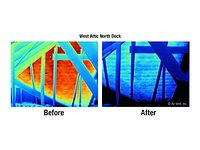Built-up roofing felts and modified bitumen roof membranes are both made up of two equally important components: reinforcement and bituminous coating. The type of reinforcement employed and the blend of the bituminous coating are critical to the success of the roof system. In recent years the types of products used in these components have changed due to a combination of technological advancements in the manufacturing process and extensive research and development on the part of roofing material manufacturers. These advancements have led to membranes and felts that provide higher performance capacity and longer life spans-elements that are critical in satisfying today's increasingly demanding building owners.
The most common types of materials used for reinforcements in these systems are now fiberglass or polyester. This is a departure from traditional BUR felts, which had used organic felts as the traditional reinforcements for built-up roofing for over 100 years. They were typically composed of organic materials, such as jute, animal hairs, shredded fabrics and cellulose. Cellulose fibers were initially made up of recycled newspapers and sawdust. Over time economic variations and material shortages led to the introduction of fiberglass felts in the marketplace. Over a 30-year span they slowly gained prominence to the point where organic materials were relegated to primary use in coal tar systems where the porosity of fiberglass felts created concerns. Polyester reinforcements were introduced into the market in the 1970s and early inclusion was in modified bitumen sheets.
Domenic Morelli of Thermo Manufacturing, Lindale, Texas, has been involved with modified bitumen and BUR manufacturing since the 1970s. "Each of these types of reinforcements have their own advantages," he says. "Both of them show excellent properties and benefits in a variety of roof systems. The decision to use one over the other depends on the specific project situation." Fiberglass and polyester each offer distinct advantages for use in BUR felts and modified bitumen membranes. That is why most of the roofing manufacturers offer materials using each of these products as reinforcements.
Selection of one reinforcement method over the other is typically based on the manufacturer's experiences with these products and the project parameters. It may be a good idea to discuss these products with your preferred manufacturers to gain further insight into the characteristics of these materials and how they perform over the long term so that you can provide your clients with the best alternative for each project.
Manufacturing of BUR Felts and Modified Bitumen Membrane
The built-up roof membrane consists of the bitumen (asphalt or coal tar) and reinforcing plies of roof felts. In the built-up roof membrane composition, the bitumen provides the waterproofing protection. The roof felt acts as a stabilizer within the system. In the manufacturing process, the reinforcement is cycled through a carrier roller and dipped into a saturation tank of the required bitumen coating, dried and rolled for packaging.The use of fiberglass and polyester reinforcements in conventional built-up roof systems is as follows:
Fiberglass Reinforcement: Asphalt-impregnated fiberglass felt is available in two types: Type IV, which has a minimum tensile strength of 44 pounds/inch and Type VI, which has a minimum tensile strength of 60 pounds/inch. Coal tar-impregnated fiberglass felt is coated in varying degrees with coal tar. There have been a number of reported problems with these types of felts and their use has diminished.
Polyester Reinforcement: Non-woven polyester felts have a high temperature dimensional stability when used in hot bitumen applications. They are predominately used in cold process-systems.
Modified bitumen membranes are manufactured by applying modified asphalt over the required reinforcement. The modified asphalt used for APP (atatic polypropylene) is a heated asphalt blend with an APP (plastic) polymer additive. The modified asphalt used for SBS (styrene-butadiene-styrene) is a heated asphalt blend with an SBS (rubber) polymer additive. In modified bitumen systems, the membrane sheet-not the bitumen as is the case for built-up roofs-is the waterproofing agent. The membrane sheets are fused together through one of four adherence methods. The reinforcements used in modified sheets differ slightly from their BUR counterparts, particularly in greater thickness.
Some of the manufacturers also offer membranes that utilize a combination of polyester and fiberglass reinforcements.
Fiberglass Felts
Fiberglass felts initially gained prominence as built-up roof felts within the last 30 years because of concerns with organic felts that were economically based (due to material shortages) and for technical variations. Fiberglass felts offered cost savings in manufacturing and were better suited for the lightweight substrates that are prominent. The fiberglass felts also have more resistance to moisture due to the porosity of the sheets. Porosity of the felts is a concern with coal tar and this marriage should be avoided. Silica sand is the prominent component of fiberglass felts and is combined with a number of selected elements and oxides.In modified bitumen membranes, fiberglass exhibits superior dimensional stability and tensile strength to polyester. Fiberglass is not affected by heat or tension. It has an inherently high melting point, which can reportedly go up to 3,000 degrees F. When a fire-retardant formulation is applied, fiberglass can provide excellent fire resistance on SBS systems. Fiberglass has excellent tensile strength. When it is used in SBS sheets, the sheets will resist roof movement until the stress building up in the mat forces it to break.
Dorothy Lawrence of Laurenco Systems Inc., Leavittsburg, Ohio, has used fiberglass reinforcements in the company's roofing and waterproofing membranes for over 60 years. In this time, she has gained a comfort level with the product's performance. She explains: "Woven fiberglass is a dimensionally stable fabric that only has one twist per inch in the yarn. This makes the product more stable and elastic." Lawrence also adds, "The twist in the weave of the fibers also makes the product easier to control in processing."
Morelli agrees with Lawrence on the advantages of fiberglass reinforcements, "Fiberglass has been a stable reinforcement for years. Its dimensional stability and tensile strength are exceptional." He further points out, "The largest attribute of fiberglass is its fire rating capabilities. Most early fire tests gave fiberglass the best fire spread rating. Multiple plies enhance these studies and ratings."
Polyester Felts
The use of polyester fibers in bituminous felts has increased in the past two decades. Polyester provides advantages attractive to roll good manufacturers. When used in BUR membranes, polyester provides superior thermal shock resistance, excellent fatigue endurance, puncture resistance and crack bridging capabilities.There are two types of polyester felts: stitchbond polyester and spunbond polyester. Stitchbond polyester is produced with fibers that are 1 to 3 inches, which are used to form nonwoven fiber mats. Special needles are stitched through the mats prior to the addition of the chemical binder that improves the strength of the mats. The mats are non-isotropic, which means they are unequal in all directions. In spunbond polyester, endless filaments are spun and immediately added to a non-woven mat. The binder may be applied to the mat by needle-punched stitching or thermal melting of the filaments together. These types of mats are isotropic, which means that they are equal in all directions.
The use of polyester reinforcements is widespread in modified bitumen systems. The primary benefit of using polyester in modified bitumen systems is for its high elongation properties and tensile strength. This is well suited to the performance of the modified bitumen coating. Polyester also exhibits high puncture resistance; tear strength and the durability to withstand high roof traffic. Morelli explains, "The true strength of polyester reinforcements are that they are much more puncture resistant then the fiberglass reinforcements." He refers to them as "the workhorse of reinforcements" and further states, "Polyester is known for tremendous puncture resistance. Considering how many other trades work on rooftop equipment, puncture resistance can be a major need in reinforcements."
Polyester also has high fire resistance capacity and its ability to withstand high temperatures has made for its predominant use with APP-modified bitumen. Polyester can remain dimensionally stable during the torching application or when applied in hot asphalt.




